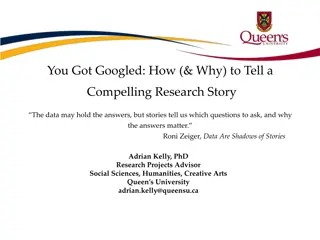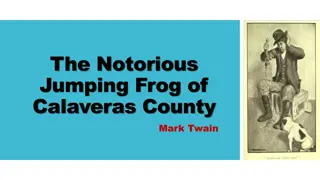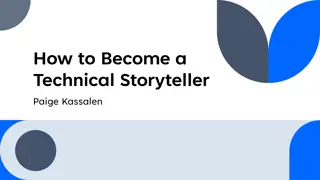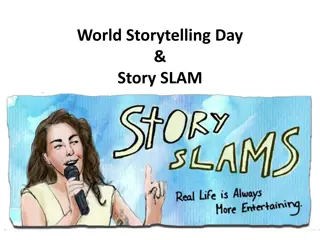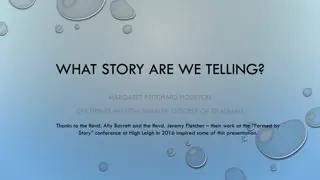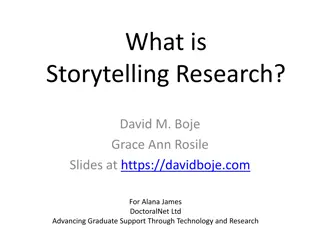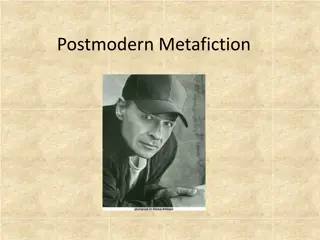Mastering Storytelling: The Power of Detail and Interaction
Explore the essence of storytelling through showing and telling, understanding the impact of specific versus abstract details, and selecting significant details. Dive into how detail breathes life into characters and narratives, and discover the art of captivating readers through vivid descriptions and meaningful interactions.
Download Presentation

Please find below an Image/Link to download the presentation.
The content on the website is provided AS IS for your information and personal use only. It may not be sold, licensed, or shared on other websites without obtaining consent from the author. Download presentation by click this link. If you encounter any issues during the download, it is possible that the publisher has removed the file from their server.
E N D
Presentation Transcript
SHOWING AND TELLING
Detail is how a story does its magic A good story doesn t lecture us about its point that s what an essay does. When we write fiction, we ask readers to come along for an experience, to feel something. However, if the story doesn t have enough grounding detail, it won t come alive for readers. Not many readers care about disembodied voices in space. Instead, a story shows readers through detail. Vivid detail pulls us into the world of the story, makes us believe and invest in the characters and action. We get to discover the layers of meaning on our own alongside the characters.
Specific versus Abstract Be very sparing with abstract statements that judge or generalize about the character. Example of Abstract writing: Debbie was a very stubborn and completely independent person and was always doing things her way despite her parents efforts to get her to conform. Her father was an executive in a dress manufacturing company and was able to afford his family all the luxuries and comforts of life. But Debbie was completely indifferent to her family s wealth. This kind of writing can be useful to you as pre-writing where you sketch your character, but it s not a very effective as a story. It s full of judgments about Debbie that have no detail backing them up. What constitutes stubbornness? Independence? Indifference? How much wealth? Debbie does not come to life here only detail can do that.
Show through details and interactions Here s a revision with specific detail: Debbie would wear a tank top and torn jeans to a corporate party if she pleased, with day-glow lizard earrings and flip-flops. Oh, sweetheart, Mrs. Chiddister would stand in the doorway wringing her hands. That s not how people dress for this kind of thing. Why not? she would say, adding an anklet of tiny bells. Mr. Chiddister was Artistic Director of the Boston branch of Cardin and had a high respect for what he called elegant textures, which ranged from handwoven tweed to gold filigree, and which he willingly offered his daughter. Debbie didn t bother trying them on anymore. (modified from Janet Burroway, Writing Fiction 8thed.) This version doesn t list the writer s judgments, but instead shows character qualities through their actions and words. We find out a great deal, but we can make up our own minds about how stubborn, wealthy, etc these people are.
Selecting significant detail Every detail should convey meaning and value. Don t drop in more stuff just because you can. For example, hair color might be important but there s a good chance it is not. Don t put it in just because it s part of a complete profile. Jennifer was a girl of nineteen, five foot six and a very thin. She had long brown hair, freckles and glasses. Her eyes were hazel with long lashes and thick eyebrows. Sound like a police profile? That s a bad sign unless your narrator is an officer. The thing about a police description: they don t know who did it; they have only a list of neutral descriptors to go on. You need to really know your character and choose the details that are unique and significant so that we feel who he or she is as an individual.
Example of significant details My family runs to heavy women, gravy-fed working women, the kind usually seen in pictures taken at mining disasters. Big women, all of my aunts move under their own power and stalk around telling everybody else what to do. But Aunt Alma was the prototype, the one I had loved most, starting back when she had given us free meals in the roadhouse she d run for awhile . . . . Once there, we d be fed on chicken gravy and biscuits, and Mama would be fed from the well of her sister s love and outrage . . . . My aunt always made biscuits. What else stretched so well? Now those starch meals shadowed her loose shoulders and dimpled her fat white elbows. From Dorothy Allison s story Don t Tell Me You Don t Know.
Writing about emotion Writers may tell the reader lots of things: that the character dropped out of high school and got a GED, or that the character hates peaches because of the fuzz. However, with very rare exceptions the characters feelings must be demonstrated: fear, love, excitement, doubt, embarrassment, despair, hope become real only when they take the form of events action (or gesture), dialogue, or physical reaction to setting.
Filtering John Gardner in The Art of Fiction: The amateur writes: Turning, she noticed two snakes fighting in among the rocks. Compare: She turned. In among the rocks two snakes were fighting . . . Generally speaking vividness urges that almost every occurrence of such phrases as she noticed and she saw be suppressed in favor of direct presentation of the thing seen. Another example of filtering (in bold): Mrs. Blair made her way to the chair by the window and sank gratefully into it. She looked out the window and there across the street she saw the ivory BMW parked in front of the fire hydrant again. It seemed to her though, that something was wrong with it. She noticed that it was listing slightly toward the back and side, and then saw that the back rim was resting almost on the asphalt. With filters removed: Mrs. Blair made her way to the chair by the window and sank gratefully into it. Across the street the ivory BMW was parked in front of the fire hydrant again. Something was wrong with it though. It was listing slightly toward the back and side, and the back rim was resting almost on the asphalt. (from Janet Burroway, Writing Fiction 8thed.)
Comparions Metaphors and similes are some of your best tools for layering detail with multiple associations. Consider Flanner O Connor s description of the mother in A Good Man Is Hard to Find as having a face as broad and innocent as a cabbage. Think of all the round things that size lots of choices. But a cabbage is rural, heavy, dense, and cheap. All those associations are layered onto the character with great economy. Be careful not to use clich d comparisons (a woman blooming like a rose; eyes that are windows to the soul, etc). If it sounds familiar, pick something fresh so readers can experience something new instead of passing over it in boredom.








